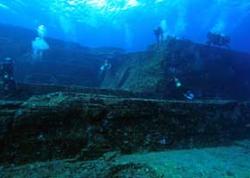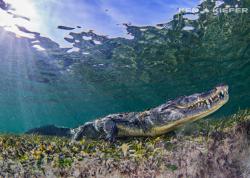The Two Faces of Dumaguete
The Two Faces of Dumaguete
Wide-Angle & Macro in the Center of the Coral Triangle
Text and Photos By Jeff Milisen

Not all tropical dive locations are created equal. Some, like Fiji and Palau, are known for an abundance of sharks. Yap has manta rays. In Hawaii, it is all about the sea turtles. The truly incredible islands of the coral triangle in the Indo-Pacific region, however, are known for all of it. This area is considered the center of marine biodiversity hosting more species of coral, fish and marine invertebrates than anywhere else on the planet. Most species of marine-life found worldwide have evolutionary roots here. And at the center of this triangle of life sits Dumaguete, Philippines.
Dumaguete is a coastal college town in the province of Negros Oriental known for its gentle people, fantastic resorts and incredible diving. One of the most popular resorts for divers is Atlantis Dumaguete where an abundance of helpful people in a prime diving location helps make it the perfect launching point. Their five boats with a maximum of 6 divers per guide have prime access to a coastline full of great diving, and the crew takes care of the busywork to make sure that you have the opportunity to make 5 dives a day every day. The only decision you really have to make is which side of Dumaguete do you want to experience: the large or the small?
Go Big!
If you are looking to be wowed by an experience, look no further than the big life at Dumaguete. The area offers two equally mind-blowing opportunities to attach your wide-angle lens. The kicker? Both experiences showcase how sustainable eco-tourism offers a win-win scenario for tourists, locals and wildlife.

On the top of nearly every diver’s bucket list sits perhaps the most iconic and charismatic animal in the ocean: the whale shark (Rhincodon typus). This gentle giant is the world’s largest shark, yet because it lacks teeth and spines, it is also the most harmless. Its diet of plankton leaves us divers off the menu. The local shrimp fishermen of Oslob in neighboring Cebu have learned a neat trick. Instead of catching the whale sharks for food, they have started feeding them with local shrimp. This means the whale sharks get a free meal, the fishermen get paid royalties for their services and eco-tourists get a once-in-a-lifetime experience with the largest fish in the ocean. And if the Oslob whale shark experience is an icon of creative sustainable practices, Apo Island is a monument.

Apo sits a short 45-minute bangka ride offshore from Atlantis Dumaguete. From the surface, the island doesn’t look like much more than a green, oceanic hill with a few houses sprinkled on it. One peek underwater, however, and your standard for pristine reef diving will be changed forever. The underwater walls at Apo are literally draped in hundreds of species of hard and soft corals. Coral colonies, in turn, create habitat for an abundance of fish, invertebrate and reptilian species. And because the area is a reserve, the wildlife is in your face. Clouds of anthias (Pseudanthias sp.) obscure your view to the surface. Armies of hawksbill sea turtles (Eretmochelys imbricata) munch at sponges in the shallows while big-eyed jacks (Caranx sexfasciatis) patrol the deep. Humphead parrotfish (Bubometopon muricatum), meanwhile, graze unfazed by the presence of divers. And this is all against a flowing landscape of corals that cannot be appropriately imagined or described. I tried desperately to capture as much as I could in the first two dives. By dive 3, I had put the camera away and opted to just enjoy my limited time in such a special place.



Or Go Small
In addition to its wide-angle opportunities, Dumaguete is known as a center for world-class muck diving. After visiting a show-stopper such as Apo Island, you would be forgiven for looking at a substrate of volcanic silt and being a bit disenchanted at first. The seemingly endless desert landscape starts at the beach and continues down the slope as far as you care to follow it. Miles of sand might be considered comparatively boring if not for the armies of cryptic life forms endlessly parading by your dive mask. The diversity of the coral triangle doesn’t only apply to corals.

Our well-trained dive masters were able to find us every rarity we requested. It started to get a bit uncanny. I mentioned before a dive that ornate ghost pipefish (Solenostomus paradoxus) had always intrigued me. At the bottom of the mooring line on our way down we found a crinoid and sure enough, a tiny ghost pipefish poked its head out for the camera. We also found robust and halimeda ghost pipefish (Solenostomus cyanopterus and S. halimeda) on the same dive. Quickly we figured out that many of our bucket list items were pretty common here, so we started doing our homework and asking about animals that hadn’t been seen in a while. For example, the divemasters confided that they hadn’t seen a flamboyant cuttlefish (Metasepia pfefferi) in months. Sure enough, by the next dive, my buddy and I each had found our own cuttlefish to play with. Finally, on my last dive I recalled a strange fish called a stargazer (Uranoscopus sp.) that looks something like an Aztec face staring up from the sand. That night, well, I think you see where this story is going.

Atlantis Dumaguete has found a few innovative ways to showcase its unique community with special dives designed to highlight certain aspects of the life there. For example, the fluoro dive uses special lights to observe Technicolor fluorescence that would otherwise go unnoticed. Spectacular green and pink animals flit through special lights as if an army of highlighters had attacked them. Also, don’t miss out on the mandarinfish (Synchiropus splendidus) mating dive. Mandarinfish typically remain hidden during the day but come out from hiding to mate every night at sunset. The displays are beautifully choreographed dances that crescendo up from the reef to a final release of gametes. The whole process is intrinsically fun to watch and tricky to photograph.


In Conclusion
Dumaguete, unlike other dive destinations, is not known for any one particular animal encounter. It is known for the experience as a whole. My dive buddy and I spent three days there and were constantly wowed by the menagerie that marched by no matter how big or how small.
Book your Trip with Bluewater Travel
Want to plan a trip to dive Dumaguete? Bluewater Travel offers the best pricing, service and advice for dive travel. Visit Bluewater Travel's Dumaguete Dive Travel page.
About the Author
Jeff Milisen is a relatively new content writer for the Underwater Photography Guide who specializes in black water and big animals. When not behind a camera, Jeff is a marine biologist working to reduce overfishing by improving methods for farming fish. Milisenphotography.yolasite.com
Further Reading
-
Diving with Devils: The Ultimate Guide to Manta Rays
-
Fascinating Underwater Fluoro Photography
-
3 Quick Tips for Dive Buddy Photos
Where to Buy
Please support the Underwater Photography Guide by purchasing your underwater photography gear through our sister site, Bluewater Photo & Video. Click, or call them at (310) 633-5052 for expert advice!
RECOMMENDED ARTICLES
SUPPORT THE UNDERWATER PHOTOGRAPHY GUIDE:
The Best Service & Prices on u/w Photo Gear
 Visit Bluewater Photo & Video for all your underwater photography and video gear. Click, or call the team at (310) 633-5052 for expert advice!
Visit Bluewater Photo & Video for all your underwater photography and video gear. Click, or call the team at (310) 633-5052 for expert advice!
The Best Pricing, Service & Expert Advice to Book your Dive Trips
 Bluewater Travel is your full-service scuba travel agency. Let our expert advisers plan and book your next dive vacation. Run by divers, for divers.
Bluewater Travel is your full-service scuba travel agency. Let our expert advisers plan and book your next dive vacation. Run by divers, for divers.






























